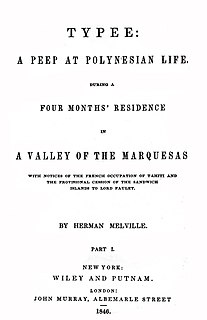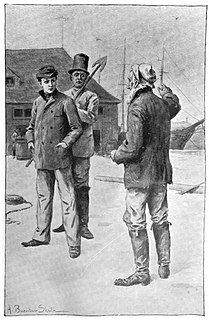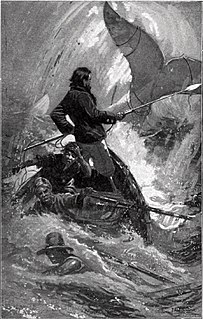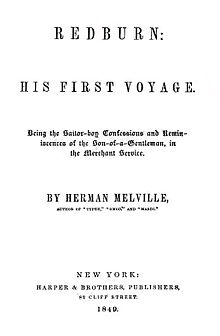
Herman Melville was an American novelist, short story writer, and poet of the American Renaissance period. Among his best-known works are Moby-Dick (1851); Typee (1846), a romanticized account of his experiences in Polynesia; and Billy Budd, Sailor, a posthumously published novella. Although his reputation was not high at the time of his death, the 1919 centennial of his birth was the starting point of a Melville revival, and Moby-Dick grew to be considered one of the great American novels.

Moby-Dick; or, The Whale is an 1851 novel by American writer Herman Melville. The book is the sailor Ishmael's narrative of the obsessive quest of Ahab, captain of the whaling ship Pequod, for revenge against Moby Dick, the giant white sperm whale that on the ship's previous voyage bit off Ahab's leg at the knee. A contribution to the literature of the American Renaissance, Moby-Dick was published to mixed reviews, was a commercial failure, and was out of print at the time of the author's death in 1891. Its reputation as a "Great American Novel" was established only in the 20th century, after the 1919 centennial of its author's birth. William Faulkner said he wished he had written the book himself, and D. H. Lawrence called it "one of the strangest and most wonderful books in the world" and "the greatest book of the sea ever written". Its opening sentence, "Call me Ishmael", is among world literature's most famous.

Typee: A Peep at Polynesian Life is the first book by American writer Herman Melville, published in the early part of 1846, when Melville was 26 years old. Considered a classic in travel and adventure literature, the narrative is based on the author's actual experiences on the island Nuku Hiva in the South Pacific Marquesas Islands in 1842, supplemented with imaginative reconstruction and research from other books. The title comes from the valley of Taipivai, once known as Taipi. Typee was Melville's most popular work during his lifetime; it made him notorious as the "man who lived among the cannibals".

Ishmael is a character in Herman Melville's Moby-Dick (1851), which opens with the line, "Call me Ishmael." He is the first person narrator in much of the book. Because Ishmael plays a minor role in the plot, early critics of Moby-Dick assumed that Captain Ahab was the protagonist. Many either confused Ishmael with Melville or overlooked the role he played. Later critics distinguished Ishmael from Melville, and some saw his mystic and speculative consciousness as the novel's central force rather than Captain Ahab's monomaniacal force of will.

Two Years Before the Mast is a memoir by the American author Richard Henry Dana Jr., published in 1840, having been written after a two-year sea voyage from Boston to California on a merchant ship starting in 1834. A film adaptation under the same name was released in 1946.

Billy Budd, Sailor is a novella by American writer Herman Melville, left unfinished at his death in 1891. Acclaimed by critics as a masterpiece when a hastily transcribed version was finally published in 1924, it quickly took its place as a classic second only to Moby-Dick among Melville's works. Billy Budd is a "handsome sailor" who strikes and inadvertently kills his false accuser, Master-at-arms John Claggart. The ship's Captain, Edward Vere, recognizes Billy's lack of intent, but claims that the law of mutiny requires him to sentence Billy to be hanged.

Francis Otto Matthiessen was an educator, scholar and literary critic influential in the fields of American literature and American studies. His best known work, American Renaissance: Art and Expression in the Age of Emerson and Whitman, celebrated the achievements of several 19th-century American authors and had a profound impact on a generation of scholars. It also established American Renaissance as the common term to refer to American literature of the mid-nineteenth century. Matthiessen was known for his support of liberal causes and progressive politics. His contributions to the Harvard University community have been memorialized in several ways, including an endowed visiting professorship.

White-Jacket; or, The World in a Man-of-War is the fifth book by American writer Herman Melville, first published in London in 1850. The book is based on the author's fourteen months' service in the United States Navy, aboard the frigate USS Neversink.

Mardi: and a Voyage Thither is the third book by American writer Herman Melville, first published in London in 1849. Beginning as a travelogue in the vein of the author's two previous efforts, the adventure story gives way to a romance story, which in its turn gives way to a philosophical quest.

Elizabeth Bruce Hardwick was an American literary critic, novelist, and short story writer.

"Benito Cereno" is a novella by Herman Melville, a fictionalized account about the revolt on a Spanish slave ship captained by Don Benito Cereno, first published in three installments in Putnam's Monthly in 1855. The tale, slightly revised, was included in his short story collection The Piazza Tales that appeared in May 1856. According to scholar Merton M. Sealts Jr., the story is "an oblique comment on those prevailing attitudes toward blacks and slavery in the United States that would ultimately precipitate civil war between North and South". The famous question of what had cast such a shadow upon Cereno was used by American author Ralph Ellison as an epigraph to his 1952 novel Invisible Man, excluding Cereno's answer, "The negro." Over time, Melville's story has been "increasingly recognized as among his greatest achievements".
The Piazza Tales is a collection of six short stories by American writer Herman Melville, published by Dix & Edwards in the United States in May 1856 and in Britain in June. Except for the newly written title story, "The Piazza," all of the stories had appeared in Putnam's Monthly between 1853 and 1855. The collection includes what have long been regarded as three of Melville's most important achievements in the genre of short fiction, "Bartleby, the Scrivener", "Benito Cereno", and "The Encantadas", his sketches of the Galápagos Islands.
"The Encantadas, or Enchanted Isles" is a novella by American author Herman Melville. First published in Putnam's Magazine in 1854, it consists of ten philosophical "Sketches" on the Encantadas, or Galápagos Islands. It was collected in The Piazza Tales in 1856. The Encantadas was a success with the critics and contains some of Melville's "most memorable prose".

The bibliography of Herman Melville includes magazine articles, book reviews, other occasional writings, and 15 books. Of these, seven books were published between 1846 and 1853, seven more between 1853 and 1891, and one in 1924. Melville was 26 when his first, and had been dead for 33 years when his last, books were published. At the time of his death he was on the verge of completing the manuscript for his first novel in three decades, Billy Budd, and had accumulated several large folders of unpublished verse.

Captain Ahab is a fictional character and one of the main protagonists in Herman Melville's Moby-Dick (1851). He is the monomaniacal captain of the whaling ship Pequod. On a previous voyage, the white whale Moby Dick bit off Ahab's leg, and he now wears a prosthetic leg made out of whalebone. The whaling voyage of the Pequod ends up as a hunt for revenge on the whale, as Ahab forces the crew members to support his fanatical mission. When Moby Dick is finally sighted, Ahab's hatred robs him of all caution, and the whale drags Ahab to his death beneath the sea.

Nautical fiction, frequently also naval fiction, sea fiction, naval adventure fiction or maritime fiction, is a genre of literature with a setting on or near the sea, that focuses on the human relationship to the sea and sea voyages and highlights nautical culture in these environments. The settings of nautical fiction vary greatly, including merchant ships, liners, naval ships, fishing vessels, life boats, etc., along with sea ports and fishing villages. When describing nautical fiction, scholars most frequently refer to novels, novellas, and short stories, sometimes under the name of sea novels or sea stories. These works are sometimes adapted for the theatre, film and television.
Raymond Melbourne Weaver was a professor of English and comparative literature at Columbia University in 1916–1948, and a literary scholar best known for publishing Herman Melville: Mariner and Mystic, the first full biography of American author Herman Melville (1819–1891) in 1921 and editing Melville's works. Weaver's scholarly credentials, training, and persuasiveness were important in launching the "Melville Revival" of the 1920s that brought Melville from obscurity to wide recognition.
John Marr and Other Sailors is a volume of poetry published by Herman Melville in 1888. Melville published twenty-five copies at his own expense, indicating that they were intended for family and friends. Henry Chapin wrote in an introduction to a reprint that "Melville's loveable freshness of personality is everywhere in evidence, in the voice of a true poet".

Herman Melville is a biography of the American author Herman Melville by Lewis Mumford, first published in 1929. Mumford, who felt a close affinity with Melville, gives both an account of the author's life and an interpretation of his works in the book, devoting particular attention to Moby-Dick and the later works published thereafter. The book played a role in the Melville revival of the 1920s, helping to affirm the author's reputation and to indicate connections between his work and later literature. The book was later republished under the title Herman Melville: A Study of His Life and Vision.
Pip, short for Pippin, is the African-American cabin-boy on the whaling-ship Pequod in Herman Melville's 1851 novel, Moby-Dick. When Pip falls overboard he is left stranded in the sea, and rescued only by chance and becomes "mad." The book's narrator, Ishmael, however, thinks that this "madness" gives Pip the power to see the world as it is. Pip is first described as "insignificant," but is the only member of the crew to awaken feelings of humanity in Ahab, the ship's monomaniacal captain.














